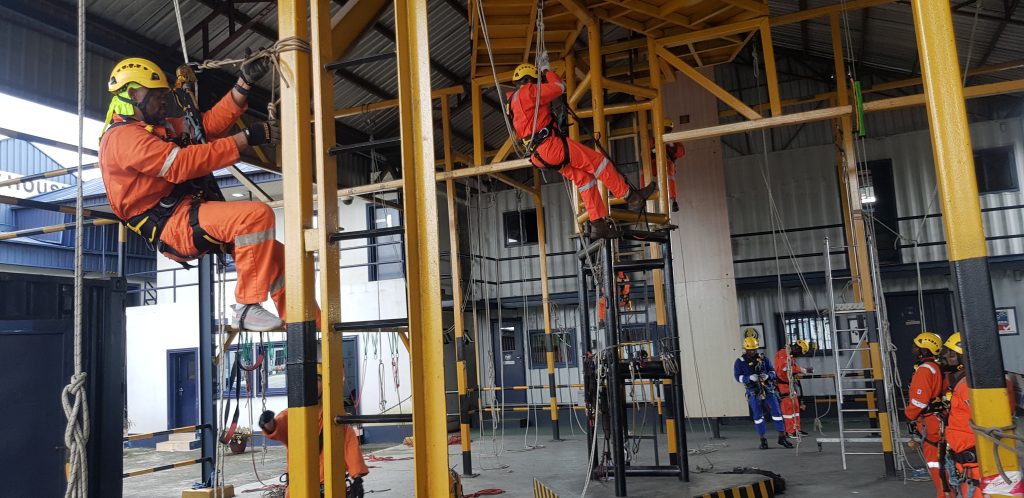
Essential Rope Access Techniques Every Rope Access Technician Must Know.
Rope access also known as industrial climbing is swiftly becoming the most preferred means of accessing heights. Industries such as oil and gas, construction, maintenance, inspection, and even rescue operations commonly use rope access. Rope access is a method of working at heights or in difficult-to-reach areas using ropes, harnesses, and specialized equipment. Unlike traditional methods like scaffolding or aerial lifts, rope access offers greater flexibility, cost-effectiveness, and minimal impact on the environment. Rope access techniques are essential for ensuring safety, ease and operational efficiency. This blog gives insights to six (6) must know techniques for rope access technicians.

Some Essential Rope Access Techniques
The following are 6 must know techniques for rope access technicians;
1. Ascending and Descending:
Ascending and descending the rope are necessary skills for a rope access technician. Mastering the essential skills of ascending and descending ropes is paramount for any rope access technician. Efficiently navigating upward and downward requires a blend of technique, precision, and balance, all while ensuring utmost safety. Ascending the rope entails utilizing specialized equipment such as docks, ascenders, and more to steadily climb towards the desired elevation. Conversely, descending involves carefully maneuvering down the ropes in a controlled manner, utilizing techniques tailored to maintain stability and control throughout the descent. As a rope access professional, proficiency in these techniques is not only crucial for completing tasks efficiently but also for ensuring personal safety and the safety of others.
2. Positioning:
It is essential for a rope access technician to know how to properly position himself while suspended on ropes to maximize productivity and minimize fatigue. This will enable a technician to access the desired height. Skillful positioning involves maintaining proper posture and alignment to facilitate access to desired heights, ensuring swift and safe task completion. By adopting ergonomic stances and utilizing anchoring points strategically, technicians can minimize strain on their bodies and maximize their endurance during prolonged work periods.

3. Tying of Knots:
Rope access technicians rely on a diverse array of knots, each serving specific purposes and requiring proficiency for effective use. Among the essential knots in rope access are the square knot, figure eight knot, figure nine knot, alpine butterfly knot, and several others. The square knot, for instance, functions as a binding knot, adeptly joining two ends of a line around an object securely. Conversely, the figure eight knot is instrumental in forming a fixed loop at the end of a line, providing stability and reliability in various rope access tasks.
4. Rigging:
Rigging is a fundamental aspect of rope access, involving the skillful tying of ropes to anchor points to facilitate safe and stable operations. Ensuring proper rigging is essential for maintaining stability and safety throughout various rope access tasks. Industry experts receive training to perfect the skill of anchoring ropes securely to structures, employing techniques aimed at evenly distributing loads and reducing accident risks. Understanding load distribution principles and applying effective rigging methods enhances safety and efficiency in rope access operations.
Some advanced techniques in rope access include:
5. Rope Rescue:
In critical emergency scenarios, this technique is used to aid colleagues facing precarious situations, such as casualty evacuation and executing self-rescue procedures. This advanced method is designed to swiftly and effectively respond to crises, ensuring the safety and well-being of all involved.
6. Fall Arrest:
Employed only under exigent circumstances, fall arrest techniques are imperative for minimizing the risks associated with free falling. When facing situations involving potential free fall, we activate fall arrest protocols to maintain control and mitigate hazards. A secure harness attachment, is paramount in upholding vertical alignment and always ensuring the safety of workers.

How Do I Become a Rope Access Technician?
An individual must be trained and certified to become a rope access technician. The Industrial Rope Access Trade Association (IRATA) is a body that has a training and certification scheme for rope access.
Rope access training generally recognizes three certification levels, each with different contents and criteria. Aspiring rope access technicians must complete training courses at various levels: IRATA Level 1, Level 2, and Level 3. JC International is a certified member of IRATA and offers IRATA Rope Access training for level 1, 2, and 3.
Mastering rope access techniques is a journey that requires adequate skills, practice, and commitment. One needs to understand the basics, master advanced techniques, and practice regularly to become a proficient rope access technician.
Want to become a Rope Access technician? Get started with us.

Leave a Reply